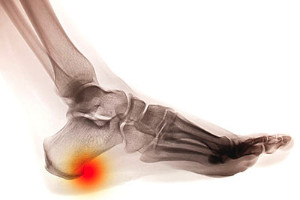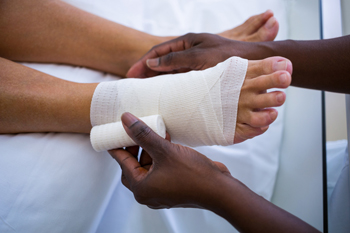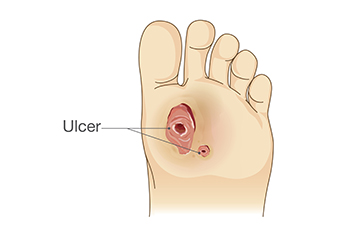
A heel spur is caused when calcium builds up on the heel bone. It can be a plantar heel spur, which grows on the bottom of the heel, or a posterior heel spur, which grows on the back of the heel. A great many people have heel spurs and won’t know it until the spurs show up on an X-ray. Others with heel spurs can experience a great deal of pain, which can be acute, intermittent, or chronic. The precise cause of heel spurs has been debated by scientists, but what is clear is that more than 80 percent of people who have them are overweight. Older people also are more likely to develop heel spurs, as are post-menopausal women. Possible causes include arthritis, plantar fasciitis, excessive running or jogging, and shoes without adequate cushioning in the heel. The two main ways to treat bone spurs are resting and icing the foot and wearing orthotic shoe inserts. If the pain caused by heel spurs continues or worsens, it is a good idea to visit a podiatrist who may suggest further treatment options, such as corticosteroid injections and being fitted for custom orthotics.
Heel spurs can be incredibly painful and sometimes may make you unable to participate in physical activities. To get medical care for your heel spurs, contact one of our podiatrists from Jill Einhorn, DPM and James Einhorn, DPM. Our doctors will do everything possible to treat your condition.
Heels Spurs
Heel spurs are formed by calcium deposits on the back of the foot where the heel is. This can also be caused by small fragments of bone breaking off one section of the foot, attaching onto the back of the foot. Heel spurs can also be bone growth on the back of the foot and may grow in the direction of the arch of the foot.
Older individuals usually suffer from heel spurs and pain sometimes intensifies with age. One of the main condition's spurs are related to is plantar fasciitis.
Pain
The pain associated with spurs is often because of weight placed on the feet. When someone is walking, their entire weight is concentrated on the feet. Bone spurs then have the tendency to affect other bones and tissues around the foot. As the pain continues, the feet will become tender and sensitive over time.
Treatments
There are many ways to treat heel spurs. If one is suffering from heel spurs in conjunction with pain, there are several methods for healing. Medication, surgery, and herbal care are some options.
If you have any questions feel free to contact our offices located in Brooklyn and Astoria, NY . We offer the latest in diagnostic and treatment technology to meet your needs.
 There is a nerve called the plantar digital nerve which is located between the toes. Morton’s neuroma is a condition that occurs when that nerve is irritated or squeezed and can happen from wearing shoes that do not have enough room in the toe area. When this nerve is inflamed the pressure is felt in the ball of the foot. The nerve can become thickened, and this ailment gradually becomes painful. Some of the symptoms that are associated with Morton’s neuroma can include the sensation of stepping on a pebble, the foot can feel numb, and the pain can travel between the third and fourth toes. This is a common condition among ballet dancers because of the style of dance they enjoy. There may also be existing medical conditions that can trigger Morton’s neuroma like hammertoe, bunions, and flat feet. If you have any of these symptoms please confer with a podiatrist who can guide you toward correct treatment options, which may include surgery for permanent removal of the nerve.
There is a nerve called the plantar digital nerve which is located between the toes. Morton’s neuroma is a condition that occurs when that nerve is irritated or squeezed and can happen from wearing shoes that do not have enough room in the toe area. When this nerve is inflamed the pressure is felt in the ball of the foot. The nerve can become thickened, and this ailment gradually becomes painful. Some of the symptoms that are associated with Morton’s neuroma can include the sensation of stepping on a pebble, the foot can feel numb, and the pain can travel between the third and fourth toes. This is a common condition among ballet dancers because of the style of dance they enjoy. There may also be existing medical conditions that can trigger Morton’s neuroma like hammertoe, bunions, and flat feet. If you have any of these symptoms please confer with a podiatrist who can guide you toward correct treatment options, which may include surgery for permanent removal of the nerve.
Morton’s neuroma is a very uncomfortable condition to live with. If you think you have Morton’s neuroma, contact one of our podiatrists of Jill Einhorn, DPM and James Einhorn, DPM. Our doctors will attend to all of your foot care needs and answer any of your related questions.
Morton’s Neuroma
Morton's neuroma is a painful foot condition that commonly affects the areas between the second and third or third and fourth toe, although other areas of the foot are also susceptible. Morton’s neuroma is caused by an inflamed nerve in the foot that is being squeezed and aggravated by surrounding bones.
What Increases the Chances of Having Morton’s Neuroma?
Morton’s neuroma is a very treatable condition. Orthotics and shoe inserts can often be used to alleviate the pain on the forefront of the feet. In more severe cases, corticosteroids can also be prescribed. In order to figure out the best treatment for your neuroma, it’s recommended to seek the care of a podiatrist who can diagnose your condition and provide different treatment options.
If you have any questions, please feel free to contact our offices located in Brooklyn and Astoria, NY . We offer the newest diagnostic and treatment technologies for all your foot care needs.

The type of doctor who specializes in foot conditions is referred to as a podiatrist. This type of doctor can diagnose and treat medical disorders of the foot and ankle. Research has indicated that podiatry dates back to ancient Egypt, and a scalpel was used to remove corns and calluses. Currently, a podiatrist will perform a physical exam in addition to listening to patients about specific foot concerns. Some of the conditions that podiatrists treat include bunions, hammertoe, and ingrown toenails. Surgery may be necessary to treat the removal of bone spurs, cysts, and tumors. Additionally, they are able to prescribe custom-made orthotics that may help to improve mobility and balance. There are doctors who choose to specialize in a specific branch of podiatry. These can consist of pediatric, sports, and advanced surgery which can rebuild the foot and ankle after an injury. Many podiatrists prefer to work in a hospital setting, general practice, or health maintenance organizations. If you think this is a positive career choice for you, please consult with a podiatrist who can help you with your decision.
If you are dealing with pain in your feet and ankles, you may want to seek help from a podiatrist. Feel free to contact one of our podiatrists from Jill Einhorn, DPM and James Einhorn, DPM. Our doctors can provide the care you need to keep you pain-free and on your feet.
What Is a Podiatrist?
A podiatrist is a doctor of podiatric medicine who diagnoses and treats conditions of the foot, ankle, and related structures of the leg. Your podiatrist may specialize in a certain field such as sports medicine, wound care, pediatrics, and diabetic care. Podiatrists have the ability to become board certified through training, clinical experience, and then taking an exam.
What Do Podiatrists Do?
On a daily basis, a podiatrist may perform the following activities:
It is very important that you take care of your feet. It’s easy to take having healthy feet for granted, however foot problems tend to be among the most common health conditions. Podiatrists can help diagnose and treat a variety of feet related conditions, so it is crucial that you visit one if you need assistance.
If you have any questions please feel free to contact our offices located in Brooklyn and Astoria, NY . We offer the newest diagnostic and treatment technologies for all your foot and ankle needs.

Diabetic patients commonly suffer from nerve damage known as diabetic neuropathy and circulatory problems in their feet. Nerve damage can cause tingling, numbness, and sensitivity, and also prevent the diabetic from feeling pain or detecting when they have a cut, crack, or another small abrasion on their feet. Any disturbance in the skin such as this would normally be able to heal, were it not for the inadequate flow of blood in the diabetic patient. So even the smallest undetected skin injury can worsen quickly and develop into a wound because it is not getting the supply of oxygen and nutrients it needs to heal. That is why it is vitally important for diabetics to inspect their feet daily and to see a podiatrist right away if anything unusual is spotted. Regular examinations with a podiatrist would be advantageous to the diabetic to prevent wounds from developing as well as be proactive about their foot health.
Wound care is an important part in dealing with diabetes. If you have diabetes and a foot wound or would like more information about wound care for diabetics, consult with one of our podiatrists from Jill Einhorn, DPM and James Einhorn, DPM. Our doctors will assess your condition and provide you with quality foot and ankle treatment.
What Is Wound Care?
Wound care is the practice of taking proper care of a wound. This can range from the smallest to the largest of wounds. While everyone can benefit from proper wound care, it is much more important for diabetics. Diabetics often suffer from poor blood circulation which causes wounds to heal much slower than they would in a non-diabetic.
What Is the Importance of Wound Care?
While it may not seem apparent with small ulcers on the foot, for diabetics, any size ulcer can become infected. Diabetics often also suffer from neuropathy, or nerve loss. This means they might not even feel when they have an ulcer on their foot. If the wound becomes severely infected, amputation may be necessary. Therefore, it is of the upmost importance to properly care for any and all foot wounds.
How to Care for Wounds
The best way to care for foot wounds is to prevent them. For diabetics, this means daily inspections of the feet for any signs of abnormalities or ulcers. It is also recommended to see a podiatrist several times a year for a foot inspection. If you do have an ulcer, run the wound under water to clear dirt from the wound; then apply antibiotic ointment to the wound and cover with a bandage. Bandages should be changed daily and keeping pressure off the wound is smart. It is advised to see a podiatrist, who can keep an eye on it.
If you have any questions, please feel free to contact our offices located in Brooklyn and Astoria, NY . We offer the newest diagnostic and treatment technologies for all your foot care needs.

A diabetic foot ulcer is an open sore or wound that affects about 15 percent of people with diabetes. There are two main types of foot ulcers, neuropathic and vascular. High blood sugar levels are thought to be the cause of both types. Being overweight, smoking, and frequently drinking alcohol are other contributing factors. People who have diabetes for years often develop neuropathy, a reduced or limited ability to feel pain in the feet. As a result, sores and cuts, especially on the bottom of the feet, may be overlooked. Vascular inefficiency, a slowed blood flow to the extremities, can reduce the ability of foot ulcers to heal properly, which increases the likelihood of infection. Tissue around a skin ulcer can become blackened, and gangrene may develop. Of those who develop a foot ulcer, up to one-fourth will be at risk of amputation. Fortunately, it is possible to prevent the formation of foot ulcers through a rigorous daily foot care regime. If an ulcer has formed, however, debridement (cutting away of dead tissue), certain medication, sterile dressings, and managing glucose are suggested. For more information on prevention and treatment of foot ulcers, please consult a podiatrist.
Diabetic foot care is important in preventing foot ailments such as ulcers. If you are suffering from diabetes or have any other concerns about your feet, contact one of our podiatrists from Jill Einhorn, DPM and James Einhorn, DPM. Our doctors can provide the care you need to keep you pain-free and on your feet.
Diabetic Foot Care
Diabetes affects millions of people every year. The condition can damage blood vessels in many parts of the body, especially the feet. Because of this, taking care of your feet is essential if you have diabetes, and having a podiatrist help monitor your foot health is highly recommended.
The Importance of Caring for Your Feet
Patients with diabetes should have their doctor monitor their blood levels, as blood sugar levels play such a huge role in diabetic care. Monitoring these levels on a regular basis is highly advised.
It is always best to inform your healthcare professional of any concerns you may have regarding your feet, especially for diabetic patients. Early treatment and routine foot examinations are keys to maintaining proper health, especially because severe complications can arise if proper treatment is not applied.
If you have any questions please feel free to contact our offices located in Brooklyn and Astoria, NY . We offer the newest diagnostic and treatment technologies for all your foot and ankle needs.